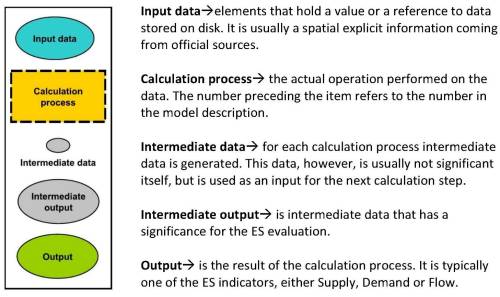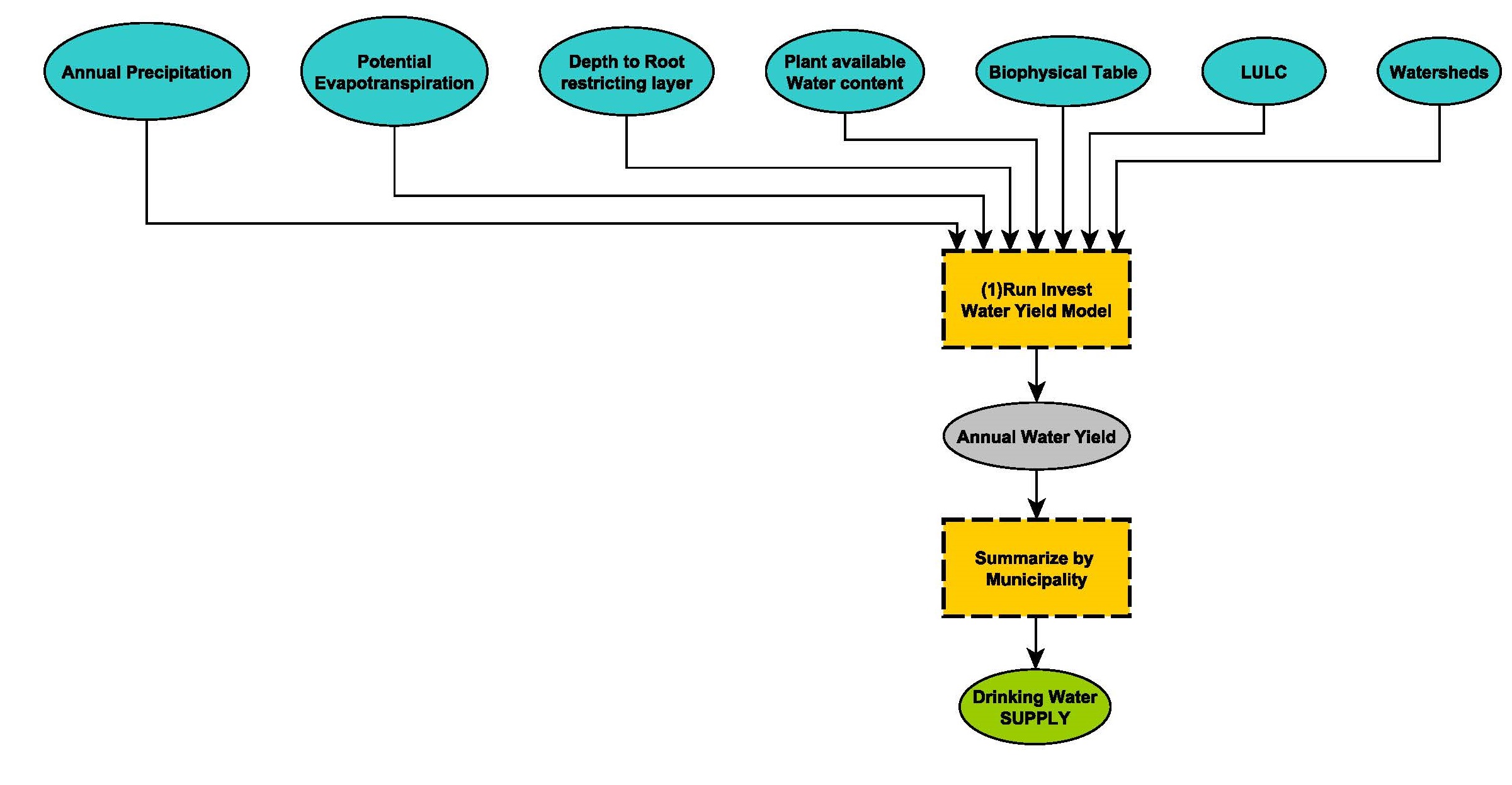Table of Contents
Surface water for drinking with minor or no treatments - Supply
General description
The surface water supply is displayed as annual average available water runoff. Using the INVEST water yield model, the annual average quantity of water runoff from each subcatchment of the Alpine space is calculated. The model estimates the water runoff based on gridded information on climatic, soil, topographic and landcover characteristics.
Input Data
- <font 14px/inherit;;inherit;;inherit>Annual average precipitation sum</font>
- <font 14px/inherit;;inherit;;inherit>Annual average evapotranspiration</font>
- <font 14px/inherit;;inherit;;inherit>Root restricting layer depth</font>
- <font 14px/inherit;;inherit;;inherit>Plant available water content</font>
- <font 14px/inherit;;inherit;;inherit>Landcover</font>
- <font 14px/inherit;;inherit;;inherit>Root depth</font>
- <font 14px/inherit;;inherit;;inherit>Evapotranspiration coefficient table</font>
- <font 14px/inherit;;inherit;;inherit>DEM</font>
- <font 14px/inherit;;inherit;;inherit>Annual average runoff</font>
Calculation processes
<font 14px/inherit;;inherit;;inherit>(1) Run INVEST water yield model</font>
<font 14px/inherit;;inherit;;inherit>Download and Install INVEST water yield model</font>
The Invest model toolbox can be downloaded at https://www.naturalcapitalproject.org/invest/ and installed on windows and mac’s. Furthermore, a very detailed User’s guide explaining the model’s configuration can be found on the mentioned homepage.
<font 14px/inherit;;inherit;;inherit>Prepare Input data for INVEST water yield model</font>
The InVEST Reservoir Hydropower model estimates the relative contributions of water from different parts of a landscape, offering insight into how land use patterns affect annual surface water yield. As the model runs on a gridded map, the majority of input data needs to be provided on a gridded map (see raster). Furthermore, due to the annual reference of the model, input data need to be provided as annual averages. As such, annual average rainfall, average annual reference evapotranspiration, root restricting layer depth, plant available water content, root depth and land use datasets need to be raster files and annually averaged where applicable. A number of base data-sets can be found in the MESH tool under https://www.naturalcapitalproject.org/mesh/. For all raster inputs, the projection used should be defined, and the projection’s linear units should be in meters. It is advisable that datasets were collected in the same year, e.g. rainfall and land use. Furthermore, polygons delineating the watershed area on large and medium scale are needed.
<font 14px/inherit;;inherit;;inherit>In a next step, the evaporation coefficient table should be calculated following the guidelines provided in the INVEST User’s guide.</font>
<font 14px/inherit;;inherit;;inherit>Run the model</font>
<font 14px/inherit;;inherit;;inherit>When the input datasets are all clipped, projected in a consistent way, they can be defined in the user’s interface of the model, which can be found as a standalone application accessible from the Windows start menu. For Windows 7 or earlier, this can be found under All Programs → InVEST |version| → Water Yield. Windows 8 users can find the application by pressing the windows start key and typing “water” to refine the list of applications. The standalone can also be found directly in the InVEST install directory under the subdirectory invest-3_x86/invest_hydropower_water_yield.exe.</font>
<font 14px/inherit;;inherit;;inherit>Interpreting the results</font>
Once done with the number crunching, the results need to be interpreted. The following short description of the outputs is extracted from the INVEST water yield model’s user’s guide, which can be found under http://data.naturalcapitalproject.org/nightly-build/invest-users-guide/html/reservoirhydropowerproduction.html#interpreting-results</font>
<font 14px/inherit;;inherit;;inherit>Outputs in the per_pixel folder within the output folder can be useful for intermediate calculations but should NOT be interpreted at the pixel level, as model assumptions are based on processes understood at the subwatershed scale.</font>
<font 14px/inherit;;inherit;;inherit>output\per_pixel\fractp(fraction): Estimated actual evapotranspiration fraction of precipitation per pixel (Actual Evapotranspiration / Precipitation). It is the mean fraction of precipitation that actually evapotranspires at the pixel level.</font>
<font 14px/inherit;;inherit;;inherit>output\per_pixel\aet(mm): Estimated actual evapotranspiration per pixel.</font>
<font 14px/inherit;;inherit;;inherit>output\per_pixel\wyield(mm): Estimated water yield per pixel.</font>
<font 14px/inherit;;inherit;;inherit>output\watershed_results_wyield.shp and output\watershed_results_wyield.csv:Shapefile and table containing output values per watershed: When the water yield model is run, the following biophysical outputs result:</font>
<font 14px/inherit;;inherit;;inherit>precip_mn(mm): Mean precipitation per pixel on the watershed.</font>
<font 14px/inherit;;inherit;;inherit>PET_mn(mm): Mean potential evapotranspiration per pixel on the watershed.</font>
<font 14px/inherit;;inherit;;inherit>AET_mn(mm): Mean actual evapotranspiration per pixel on the watershed.</font>
<font 14px/inherit;;inherit;;inherit>wyield_mn(mm): Mean water yield per pixel on the watershed.</font>
<font 14px/inherit;;inherit;;inherit>num_pixels: Number of pixels per watershed.</font>
<font 14px/inherit;;inherit;;inherit>wyield_vol(m3): Volume of water yield in the watershed.</font>
<font 14px/inherit;;inherit;;inherit>wyield_ha(m3): Volume of water yield in the watershed per hectare.</font>
<font 14px/inherit;;inherit;;inherit>Calibration</font>
As most input data, were physically determined values, and hence are not to be changed. The calibration, after assessing the sensitivity was done with the annually average evapotranspiration coefficient. Therefore, comparing the dataset with the observation-based map of mean annual runoff from Beck (2012), step-wise adjustments of the KC- (Evapotranspiration coefficient table)values are made towards minimising the error to reach a threshold of max 10-15 % error rate. This was done in a semi-automatic calibration scheme in python and R environment.

